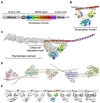The Emerging Role of the RNA-Binding Protein SFPQ in Neuronal Function and Neurodegeneration
- PMID: 32998269
- PMCID: PMC7582472
- DOI: 10.3390/ijms21197151
The Emerging Role of the RNA-Binding Protein SFPQ in Neuronal Function and Neurodegeneration
Abstract
RNA-binding proteins (RBPs) are a class of proteins known for their diverse roles in RNA biogenesis, from regulating transcriptional processes in the nucleus to facilitating translation in the cytoplasm. With higher demand for RNA metabolism in the nervous system, RBP misregulation has been linked to a wide range of neurological and neurodegenerative diseases. One of the emerging RBPs implicated in neuronal function and neurodegeneration is splicing factor proline- and glutamine-rich (SFPQ). SFPQ is a ubiquitous and abundant RBP that plays multiple regulatory roles in the nucleus such as paraspeckle formation, DNA damage repair, and various transcriptional regulation processes. An increasing number of studies have demonstrated the nuclear and also cytoplasmic roles of SFPQ in neurons, particularly in post-transcriptional regulation and RNA granule formation. Not surprisingly, the misregulation of SFPQ has been linked to pathological features shown by other neurodegenerative disease-associated RBPs such as aberrant RNA splicing, cytoplasmic mislocalization, and aggregation. In this review, we discuss recent findings on the roles of SFPQ with a particular focus on those in neuronal development and homeostasis as well as its implications in neurodegenerative diseases.
Keywords: DBHS protein family; Drosophila behavior human splicing; RNA-binding protein; SFPQ; cytoplasmic aggregation; neurodegenerative disease; nuclear protein; stress granules.
Conflict of interest statement
The authors declare no conflict of interest.
Figures



Similar articles
-
Cytoplasmic Aggregates of Splicing Factor Proline-Glutamine Rich Disrupt Nucleocytoplasmic Transport and Induce Persistent Stress Granules.J Cell Mol Med. 2024 Dec;28(23):e70261. doi: 10.1111/jcmm.70261. J Cell Mol Med. 2024. PMID: 39636149 Free PMC article.
-
Structural basis of the zinc-induced cytoplasmic aggregation of the RNA-binding protein SFPQ.Nucleic Acids Res. 2020 Apr 6;48(6):3356-3365. doi: 10.1093/nar/gkaa076. Nucleic Acids Res. 2020. PMID: 32034402 Free PMC article.
-
Structural plasticity of the coiled-coil interactions in human SFPQ.Nucleic Acids Res. 2025 Jan 11;53(2):gkae1198. doi: 10.1093/nar/gkae1198. Nucleic Acids Res. 2025. PMID: 39698821 Free PMC article.
-
Role of RNA binding proteins of the Drosophila behavior and human splicing (DBHS) family in health and cancer.RNA Biol. 2024 Jan;21(1):1-17. doi: 10.1080/15476286.2024.2332855. Epub 2024 Mar 29. RNA Biol. 2024. PMID: 38551131 Free PMC article. Review.
-
Relation Between Stress Granules and Cytoplasmic Protein Aggregates Linked to Neurodegenerative Diseases.Curr Neurol Neurosci Rep. 2018 Nov 8;18(12):107. doi: 10.1007/s11910-018-0914-7. Curr Neurol Neurosci Rep. 2018. PMID: 30406848 Review.
Cited by
-
Stress granules: Guardians of cellular health and triggers of disease.Neural Regen Res. 2026 Feb 1;21(2):588-597. doi: 10.4103/NRR.NRR-D-24-01196. Epub 2025 Feb 24. Neural Regen Res. 2026. PMID: 39995077 Free PMC article.
-
An integrative analysis of cell-specific transcriptomics and nuclear proteomics of sleep-deprived mouse cerebral cortex.Sci Rep. 2025 Jul 29;15(1):27677. doi: 10.1038/s41598-025-10783-8. Sci Rep. 2025. PMID: 40730573 Free PMC article.
-
Identifying Novel Actionable Targets in Colon Cancer.Biomedicines. 2021 May 20;9(5):579. doi: 10.3390/biomedicines9050579. Biomedicines. 2021. PMID: 34065438 Free PMC article. Review.
-
TIMAP, a Regulatory Subunit of Protein Phosphatase 1, Inhibits In Vitro Neuronal Differentiation.Int J Mol Sci. 2023 Dec 11;24(24):17360. doi: 10.3390/ijms242417360. Int J Mol Sci. 2023. PMID: 38139189 Free PMC article.
-
SFPQ and Its Isoform as Potential Biomarker for Non-Small-Cell Lung Cancer.Int J Mol Sci. 2023 Aug 6;24(15):12500. doi: 10.3390/ijms241512500. Int J Mol Sci. 2023. PMID: 37569873 Free PMC article.
References
Publication types
MeSH terms
Substances
Grants and funding
LinkOut - more resources
Full Text Sources
Medical
Molecular Biology Databases

